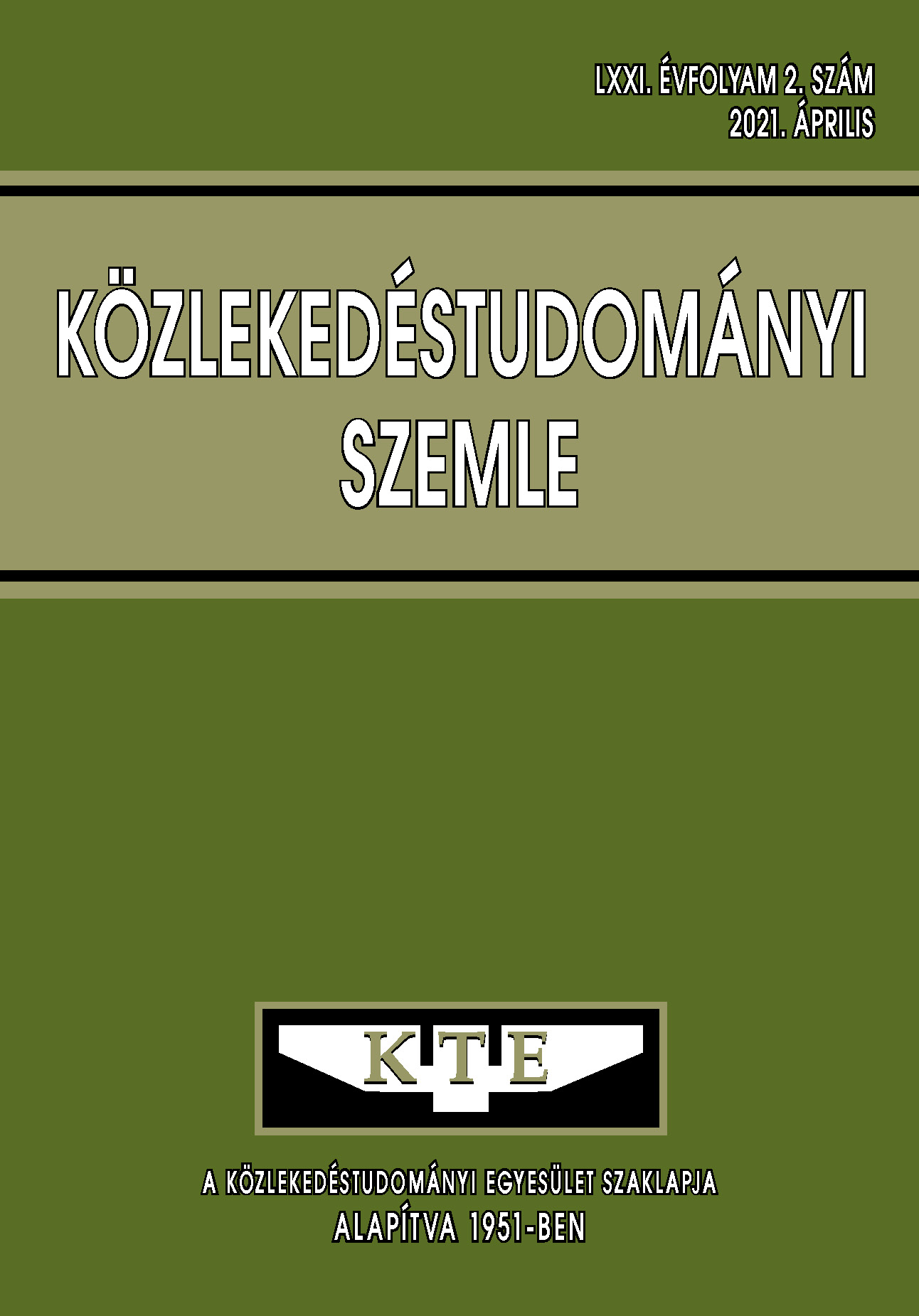Conflict situation of road infrastructure with highly automated vehicles
Abstract
Road signs and transport infrastructure significantly influence the behaviour of highly automated or autonomous vehicles. However, automation is not always an advantage in consideration of the current road infrastructure. It can occur that highly automated vehicles are more compliant with traffic rules, causing selfdriving functions to perform unexpected interventions while vehicles are moving. However, in many cases this can also be a problem because the rules themselves are not always appropriate. In practice, this means that autonomous functions make it easier for self-driving and non-selfdriving vehicles to conflict in certain situations. This paper highlights the potential dangers and uncertainties of highly automated or autonomous vehicles in the context of the current – conventional – transport infrastructure.
References
A. Szele; L. Kisgyörgy, Autonomous Vehicles In Sustainable Cities: More Questions Than Answers, in Sustainable Development and Planning X, WIT Press, 2018 DOI: https://doi.org/10.2495/SDP180611
A. Torok; T. Derenda; M. Zanne,; M. Zoldy, Automatization in road transport: a review Production Engineering Archives, Stowarzyszenie Menedzerow Jakosci i Produkcji, 2018, 20, 3-7 DOI: https://doi.org/10.30657/pea.2018.20.01
C. Csiszár; D. Földes, Operational Model and Impacts of Mobility Service Based on Autonomous Vehicles University of Belgrade, Faculty of Transport and Traffic Engineering, University of Belgrade, Faculty of Transport and Traffic Engineering, 2018
H. Prakken, On the problem of making autonomous vehicles conform to traffic law Artificial Intelligence and Law, Springer Netherlands, 2017, 25, 341-363 DOI: https://doi.org/10.1007/s10506-017-9210-0
C. G.Serna; Y.Ruichek..Classification of Traffic Signs: The European Dataset IEEE Access, Institute of Electrical and Electronics Engineers (IEEE), 2018, 6, 78136-78148 DOI: https://doi.org/10.1109/ACCESS.2018.2884826
G. Richter; L. Grohmann; P. Nitsche; G. Lenz, Anticipating Automated Vehicle Presence and the Effects on Interactions with Conventional Traffic and Infrastructure EPiC Series in Computing, 2019, 62, 230-243
SAE J3016 automated-driving graphic, SAE Standards, 2019
European Commission, Advanced driver assistance systems, European Commission, Directorate General for Transport, European Commission, 2016
ISO - ISO 7635:2006 - Road vehicles — Air and air/hydraulic braking systems of motor vehicles, including those with electronic control functions — Test procedures
ISO - ISO 15622:2018 - Intelligent transport systems — Adaptive cruise control systems — Performance requirements and test procedures
ISO - ISO 11835:2002 - Road vehicles — Motor vehicles with antilock braking systems (ABS) — Measurement of braking performance
J. Lukacs, A Fuzzy Approach for In-Car Sound Quality Prediction, Acta Polytechnica Hungarica, 2020
J.-F. Bonnefon; A. Shariff; I. Rahwan, The social dilemma of autonomous vehicles Science, American Association for the Advancement of Science (AAAS), 2016, 352, 1573-1576 DOI: https://doi.org/10.1126/science.aaf2654
H. Surden; M.-A Williams, Technological opacity predictability and self-driving cars, SSRN Electronic Journal, Elsevier BV, 2016
J. M. Anderson; N. Kalra, K. D. Stanley, Autonomous Vehicle Technology: A Guide for Policymakers, Rand Corporation, RAND CORP, 2014
R. Leenes,; F. Lucivero, Laws on Robots, Laws by Robots, Laws in Robots: Regulating Robot Behaviour by Design
Law, Innovation and Technology, Informa UK Limited, 2014, 6, 193-220 DOI: https://doi.org/10.5235/17579961.6.2.194
D. Milakis; B. van Arem; B. van Wee, Policy and society related implications of automated driving: A review of literature and directions for future research, Journal of Intelligent Transportation Systems, Informa UK Limited, 2017, 21, 324-348 DOI: https://doi.org/10.1080/15472450.20171291351
Y. Wei; C. Avcı; J. Liu; B. Belezamo; N. Aydın; P. Li; X. Zhou, Dynamic programmingbased multi-vehicle longitudinal trajectory optimization with simplified car following models, Transportation Research Part B: Methodological, Elsevier BV, 2017, 106, 102-129 DOI: https://doi.org/10.1016/j.trb.2017.10.012
G. Melegh. Neue Methoden in der Unfallrekonstruktion – Virtual Crash. EVU, Volume: 1(1):1–10, 2007
G. Melegh, G. Vida, D. Sucha, G. Belobrad, Simulation study of pedestrian impact and throw-distance. Validation of the Virtual Crash program, 2007
Bob Scurlock. Reconstruction of 60 º Frontto-Side Staged Collisions with the Virtual CRASH Software Application. Accident Reconstruction Journal, 2017
Johannes Edelmann, Manfred Plöchl, and Peter Pfeffer, editors. Advanced Vehicle Control. CRC Press, dec 2016
Karol Sztwiertnia and Guzek Marek. Uncertainty of determining the energy equivalent speed of a vehicle collision by the experimental and analytical method. The Archives of Automotive Engineering, 2017 DOI: https://doi.org/1014669/AM.VOL76.ART7
Articles published electronically are open access (OJS), freely available online and can be downloaded. Authors of articles are not charged any publication or publishing costs (APC). Users have the right to read, download, copy, print, and search the articles, or share the full text with a link.
Authors must declare that their submission has not been previously published in another journal, that financial support has been acknowledged, and that the list of references is complete and accurate, including specification of URLs and DOIs (if available). When submitting a draft article, each author approves the submitted version. Authors guarantee that the article is their original work. Authors are required to participate in the peer review process, follow the advice of reviewers, meet the prescribed deadlines, and, if any, withdraw the submission or correct errors.
All submitted articles are subject to peer review, where the editors request an independent evaluation from at least one expert, ensuring that the reviewer(s) have no conflicts of interest with the authors. The final decision is made by the Editor-in-Chief, who takes into account the evaluations and the suggestions of the editors. The editors and reviewers treat the submission confidentially.
The publisher and editors are committed to maintaining high ethical standards and to preventing publications that involve research misconduct. They follow the COPE guidelines on such ethical issues.
The authors retain copyright and grant the journal the right of first publication under the Creative Commons License (https://creativecommons.org/licenses/by-nc-nd/4.0), which allows others to share the work, while acknowledging the authorship of the work and the first publication in the journal.
The journal archives all published articles, and the journal's owner, the Hungarian Society of Transportation Sciences, will continue to operate the database even if the journal ceases to be published.















